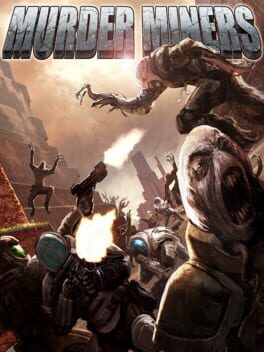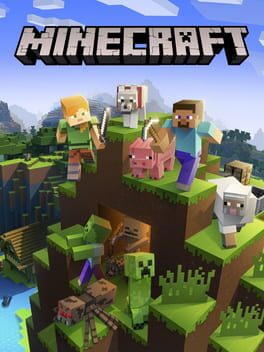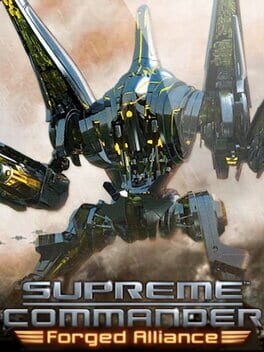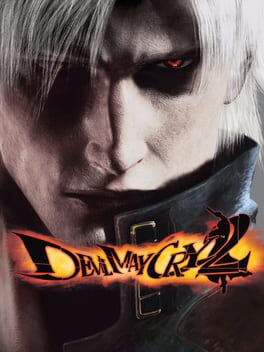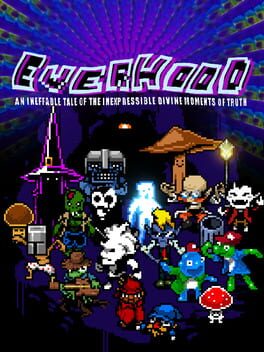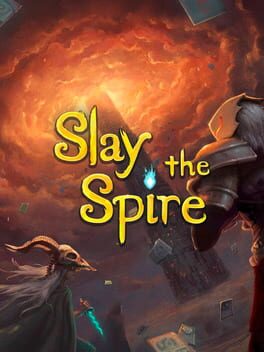epicuu
63 reviews liked by epicuu
Murder Miners
2012
Minecraft
2011
Devil May Cry 2
2012
Everhood
2021
Hyper Light Drifter
2016
Every 12 months, it seems like all of gaming media conspires to get together and collectively select THE hottest indie darling of the year. In 2022 it was Cult of the Lamb, before that It Takes Two (2021), Hades (2020), Outer Wilds (2019), Subnautica (2018), Hollow Knight (2017), etc… Well, those of you who were gaming back in the day no doubt remember which release took the cake circa 2016, that of course being Hyper Light Drifter. A visual throwback to third and fourth gen titles, Hyper Light Drifter was interesting in that its gameplay was more reminiscent of contemporary hack-and-slash titles, producing a hybrid that appealed to both retro buyers and newbies alike. Seven years later, the question remains: does it still hold up as a gold standard from the AA market?
Based on my experience, the unfortunate truth is not really, though it does have its pros, the first of those of course being the graphics. If there’s one word that perfectly describes the aesthetic drafted by developer Heart Machine, it would be calming. Take a gander at any screenshot or piece of footage from this game; let the soft hues envelope your ocular globes, the pixel-perfect geometry captivate your soul, the dark neons ease you into a slumber…
Jokes aside, this is a genuinely serene world. Every color under the rainbow has seemingly been incorporated into the environments about you, yet it all feels equilibrious, as though some god sculpted everything from the same slab of digital clay. That said, there’s no doubt HLD shines best when it embraces more aphotic overlays. These typically sprout whenever you’re underground (more on that later), and man are they a sight to behold: whether it’s decrepit tech or spunky rock formations, the red/blue/purple motif bathes it all with cool tranquility. If there was ever an argument against photorealism scapes in video games, HLD would be a pristine candidate: a promethean extravaganza of somber chroma. We’ve all played games that had one or two hubs decked in such placidity- HLD is the first time I can say 90% of its content could fall under the same label.
The biggest drawback in this category is the poor environmental storytelling. As you’ve no doubt heard, HLD doesn’t feature a narrative in the conventional sense- there are a few cutscenes you’re periodically hit with (more on that later), but it’s otherwise a tale you largely have to interpret based on the imagery around you, and the problem is HLD is all over the place in terms of its physical layout. You’ll find Metroid-esque labs, mountaintops adorned with tribal totems, crystalline forests ala Secret of Mana, etc…and it never once comes across as a cohesive package. In fact, I’d go so far as to say creator Alx Preston was more interested in paying homage to those aforementioned titles than conceiving a unique mythos for his baby, and while it may result in a bunch of visual treats, it does come at the cost of narratological cohesiveness. Each venture you take is less about learning about this society and more about finding a new 90s throwback to gaze over if that makes sense.
I also would’ve appreciated a lot more blood splatter effects given the sheer amount of slicing-and-dicing you’ll be doing, which brings me to the gameplay. Like I stated before, HLD is a slash ‘em up, meaning its mechanics are based entirely on skewering opposing forces via your laser sword. To prevent button-mashing monotony, an instantaneous dash feature and firearm have been incorporated, and, at its best, HLD truly feels like a gun kata film: bursting into close quarters, slivering some thug, and blasting his buddy at a distance before leaping back to safety in the span of 3 seconds is absolutely exhilarating, and you’ll have to master this technique should you want to proceed through the harder areas. But unfortunately, that initial excitement wears off fast the moment you realize you’re going to be doing the exact same action again and again and again. The core problem with HLD’s loop is its failure to spice it up -- enemies aren’t radically different to warrant new tactics, the grid doesn’t deviate from its standard size, nothing. It’s just nonstop action. A lot of comparisons have been made to A Link to the Past given the presence of Zelda-esque dungeons and the ability to tackle 3/4 of them at your own pace, but the difference is those dungeons provided puzzles to jumble up the constant action. In HLD, the best you’ll get are activating switches, which are either way hidden behind guys you’ll have to, yup that’s right, KILL. And contrary to what Wikipedia claims, this is not an action RPG- all that murdering doesn’t give you experience points, and customization/inventory is limited to a few basic outfits and guns. While the upgrades (more on that later) make fighting easier, they fall short of innovation, and as a result, HLD drags, feeling just as long as ALTTP despite being half its length.
Not helping either of these is the perpetual backtracking you’ll have to do. See, unlocking boss stages and upgrades requires you to harvest special collectibles strewn throughout the world, and minus two pointed out to you by a local ally, there are no pinpoints on the map, meaning you gotta explore to find them. This doesn’t seem bad on the surface, but where the issue arises is the lack of a completion mark indicating you’ve already acquired something (again, save the two aforementioned ones), meaning you’ll often find yourself revisiting the same tunnels and closed-off areas in the hopes of uncovering an additional secret. And should you leave and return to one of the main junctures, all those gremlins you slew are brought back to life.
The larger qualm with HLD’s exploration is that the developers just didn’t do a good job arranging the spaces with distinguishable strata. In most top-down video games, you can tell where a hidden ingress is located by way of how certain objects appear: there’s a strange break in the wall, the trees are organized like an arrow, why is an odd boulder in the middle of nowhere, etc…In HLD, you’ll see TONS of these in every square that don’t lead ANYWHERE. And yet, that very same tactic has been used to conceal the canisters you need, meaning you’re going to be wasting your time slamming every suspicious-looking nook and cranny until you happen upon the right one. It’s not a compliment when I have to recommend employing a walkthrough to avoid needless frustration.
It’s a shame because an easy fix would’ve been simply giving the map a normal interface alongside the ability to set waypoints, instead of this confusing excuse of a menu with multiple levels and colors that barely show anything and don’t correspond to your actual location (one section saw me enter/exit a cave, only for the map to depict me radically moving an entire yard….what?).
As you can guess, the minimalist plot doesn’t make these excursions worth the trouble. A handful of beautifully-rendered pictel cutscenes hint at an interesting backstory for the unnamed protagonist, but it’s deliberately left vague for players to input their own interpretations. If I was younger, I probably would’ve found such an ordeal enticing, but as an adult, I gotta be honest- I consider these approaches to be more lazy than anything else. The devs either couldn’t pay for writers or thought they could tell a better story with pictures over words, the result, regardless, being no fruit borne. It shouldn’t be my job as a consumer to fill in the gaps of the world’s and/or character’s backstory- even the most carte blanche RPG provides some concrete method of understanding what’s going on. Heck, even Limbo, which HLD no doubt took inspiration from, had the wherewithal to implement a clear premise- after 7 hours, I still don’t get why anything was happening or why I was doing the actions I was doing.
If I can end this review on a positive note, it’s that the soundscape is pretty dang good. While there is SFX (more on that momentarily), HLD takes the Gravity approach of boosting action beats with the score, a smorgasbord of synthesizers that pump ethereal harmonies whilst you make your way across the different realms. The various compositions you hear resemble a midway point between No Man’s Sky and Secret of Mana’s OSTs in terms of electronica complimenting the unknown zeal of your forthcoming adventure.
A decent assemblage of sound effects have been programmed for your tools and weapons. While I would’ve liked to have seen more collision noises for the sword swipes in relation to enemies and static items, there’s enough oomph to make the relentless action non-iterant (not to mention bosses are uniquely sonorous).
In the end, though, I personally cannot vouch for Hyper Light Drifter. It’s a gorgeous game full of fantastic moments, but those are sadly unable to counter the incessant gameplay loop that fails to diversify your playtime.
NOTES
-The Drifter looks cool in cinematics. However, in-game, I can’t be the only person who thinks his helmet looks like an owl?
Based on my experience, the unfortunate truth is not really, though it does have its pros, the first of those of course being the graphics. If there’s one word that perfectly describes the aesthetic drafted by developer Heart Machine, it would be calming. Take a gander at any screenshot or piece of footage from this game; let the soft hues envelope your ocular globes, the pixel-perfect geometry captivate your soul, the dark neons ease you into a slumber…
Jokes aside, this is a genuinely serene world. Every color under the rainbow has seemingly been incorporated into the environments about you, yet it all feels equilibrious, as though some god sculpted everything from the same slab of digital clay. That said, there’s no doubt HLD shines best when it embraces more aphotic overlays. These typically sprout whenever you’re underground (more on that later), and man are they a sight to behold: whether it’s decrepit tech or spunky rock formations, the red/blue/purple motif bathes it all with cool tranquility. If there was ever an argument against photorealism scapes in video games, HLD would be a pristine candidate: a promethean extravaganza of somber chroma. We’ve all played games that had one or two hubs decked in such placidity- HLD is the first time I can say 90% of its content could fall under the same label.
The biggest drawback in this category is the poor environmental storytelling. As you’ve no doubt heard, HLD doesn’t feature a narrative in the conventional sense- there are a few cutscenes you’re periodically hit with (more on that later), but it’s otherwise a tale you largely have to interpret based on the imagery around you, and the problem is HLD is all over the place in terms of its physical layout. You’ll find Metroid-esque labs, mountaintops adorned with tribal totems, crystalline forests ala Secret of Mana, etc…and it never once comes across as a cohesive package. In fact, I’d go so far as to say creator Alx Preston was more interested in paying homage to those aforementioned titles than conceiving a unique mythos for his baby, and while it may result in a bunch of visual treats, it does come at the cost of narratological cohesiveness. Each venture you take is less about learning about this society and more about finding a new 90s throwback to gaze over if that makes sense.
I also would’ve appreciated a lot more blood splatter effects given the sheer amount of slicing-and-dicing you’ll be doing, which brings me to the gameplay. Like I stated before, HLD is a slash ‘em up, meaning its mechanics are based entirely on skewering opposing forces via your laser sword. To prevent button-mashing monotony, an instantaneous dash feature and firearm have been incorporated, and, at its best, HLD truly feels like a gun kata film: bursting into close quarters, slivering some thug, and blasting his buddy at a distance before leaping back to safety in the span of 3 seconds is absolutely exhilarating, and you’ll have to master this technique should you want to proceed through the harder areas. But unfortunately, that initial excitement wears off fast the moment you realize you’re going to be doing the exact same action again and again and again. The core problem with HLD’s loop is its failure to spice it up -- enemies aren’t radically different to warrant new tactics, the grid doesn’t deviate from its standard size, nothing. It’s just nonstop action. A lot of comparisons have been made to A Link to the Past given the presence of Zelda-esque dungeons and the ability to tackle 3/4 of them at your own pace, but the difference is those dungeons provided puzzles to jumble up the constant action. In HLD, the best you’ll get are activating switches, which are either way hidden behind guys you’ll have to, yup that’s right, KILL. And contrary to what Wikipedia claims, this is not an action RPG- all that murdering doesn’t give you experience points, and customization/inventory is limited to a few basic outfits and guns. While the upgrades (more on that later) make fighting easier, they fall short of innovation, and as a result, HLD drags, feeling just as long as ALTTP despite being half its length.
Not helping either of these is the perpetual backtracking you’ll have to do. See, unlocking boss stages and upgrades requires you to harvest special collectibles strewn throughout the world, and minus two pointed out to you by a local ally, there are no pinpoints on the map, meaning you gotta explore to find them. This doesn’t seem bad on the surface, but where the issue arises is the lack of a completion mark indicating you’ve already acquired something (again, save the two aforementioned ones), meaning you’ll often find yourself revisiting the same tunnels and closed-off areas in the hopes of uncovering an additional secret. And should you leave and return to one of the main junctures, all those gremlins you slew are brought back to life.
The larger qualm with HLD’s exploration is that the developers just didn’t do a good job arranging the spaces with distinguishable strata. In most top-down video games, you can tell where a hidden ingress is located by way of how certain objects appear: there’s a strange break in the wall, the trees are organized like an arrow, why is an odd boulder in the middle of nowhere, etc…In HLD, you’ll see TONS of these in every square that don’t lead ANYWHERE. And yet, that very same tactic has been used to conceal the canisters you need, meaning you’re going to be wasting your time slamming every suspicious-looking nook and cranny until you happen upon the right one. It’s not a compliment when I have to recommend employing a walkthrough to avoid needless frustration.
It’s a shame because an easy fix would’ve been simply giving the map a normal interface alongside the ability to set waypoints, instead of this confusing excuse of a menu with multiple levels and colors that barely show anything and don’t correspond to your actual location (one section saw me enter/exit a cave, only for the map to depict me radically moving an entire yard….what?).
As you can guess, the minimalist plot doesn’t make these excursions worth the trouble. A handful of beautifully-rendered pictel cutscenes hint at an interesting backstory for the unnamed protagonist, but it’s deliberately left vague for players to input their own interpretations. If I was younger, I probably would’ve found such an ordeal enticing, but as an adult, I gotta be honest- I consider these approaches to be more lazy than anything else. The devs either couldn’t pay for writers or thought they could tell a better story with pictures over words, the result, regardless, being no fruit borne. It shouldn’t be my job as a consumer to fill in the gaps of the world’s and/or character’s backstory- even the most carte blanche RPG provides some concrete method of understanding what’s going on. Heck, even Limbo, which HLD no doubt took inspiration from, had the wherewithal to implement a clear premise- after 7 hours, I still don’t get why anything was happening or why I was doing the actions I was doing.
If I can end this review on a positive note, it’s that the soundscape is pretty dang good. While there is SFX (more on that momentarily), HLD takes the Gravity approach of boosting action beats with the score, a smorgasbord of synthesizers that pump ethereal harmonies whilst you make your way across the different realms. The various compositions you hear resemble a midway point between No Man’s Sky and Secret of Mana’s OSTs in terms of electronica complimenting the unknown zeal of your forthcoming adventure.
A decent assemblage of sound effects have been programmed for your tools and weapons. While I would’ve liked to have seen more collision noises for the sword swipes in relation to enemies and static items, there’s enough oomph to make the relentless action non-iterant (not to mention bosses are uniquely sonorous).
In the end, though, I personally cannot vouch for Hyper Light Drifter. It’s a gorgeous game full of fantastic moments, but those are sadly unable to counter the incessant gameplay loop that fails to diversify your playtime.
NOTES
-The Drifter looks cool in cinematics. However, in-game, I can’t be the only person who thinks his helmet looks like an owl?
Slay the Spire
2019
Slay the Spire is a stroke of genius. While also being heavily weighed down by rng and stale repetitive design. My first 19 hours of this game was massive fails one after another. Then in my last 3 attempts I managed to reach the end twice in a row. With that said on my last attempt getting wrecked in a random encounter early in act one, made me think is STS more skill or luck? Latter being the bane of my existence. I ultimately put this game down feeling content with what I played. I just feel that roguelike and deck building create way too many variables to be anything other than luck.
Even after becoming more aware of the handful of viable builds, one could make I still found myself losing out to rng a little too frequently. Which the number of possible builds for each character is staggering and with that comes near infinite hours of trial and error. Experimentation is the key here. The question being why would I want to though? Even when I make it to the end of act 3, I just die anyway. Each run also has a very small pool of enemies and each run despite the cards you use feel too repetitive for my taste. I don't normally find repetition to be necessarily a bad thing. After all some of the best games have simple to complex gameplay loops. My problem is when the loop feels stale. I've read there is an act 4 but I don't feel inspired to figure it out.
This game may not be my jam but if a roguelike/deckbuilder is your thang. You will find a huge number of hours of enjoyment in STS.
Even after becoming more aware of the handful of viable builds, one could make I still found myself losing out to rng a little too frequently. Which the number of possible builds for each character is staggering and with that comes near infinite hours of trial and error. Experimentation is the key here. The question being why would I want to though? Even when I make it to the end of act 3, I just die anyway. Each run also has a very small pool of enemies and each run despite the cards you use feel too repetitive for my taste. I don't normally find repetition to be necessarily a bad thing. After all some of the best games have simple to complex gameplay loops. My problem is when the loop feels stale. I've read there is an act 4 but I don't feel inspired to figure it out.
This game may not be my jam but if a roguelike/deckbuilder is your thang. You will find a huge number of hours of enjoyment in STS.
Slay the Spire
2019
A deck-building card game roguelike seems like an interesting idea, but generally a card game video game needs a wide variety of cards to keep fresh. Along with that, a roguelike needs to try to keep a sense of progress and improvement to seem fresh for how quick and dirty a run or three can be. Slay the Spire lacks any of these things. This game only having 3-4 extremely repetitive segments doesn't help matters either. The amount of decks you can build per character, while seemingly limitless, is truly rather small and full of pretty shallow differences.
I don't think I've really played many roguelikes where I've legitimately felt like I didn't want to continue after ending a given run besides maybe Risk of Rain 1. This game wears at one's stamina; the amount of tangible progress is minimal, and the unlocks from said progress are pretty pitiful. Even after having played some roguelikes and roguelites with little to no metaprogression, I don't think any of them felt like they respected my time and patience as little as Slay the Spire. That isn't to say the game is badly made; it's pretty good for a random indie despite its pretty deep flaws, and it's a clean piece I really do hope the devs are proud of.
Still, Slay the Spire unfortunately combines the worst of both worlds from its two genres: the repetitive, shallow parts of a roguelike are mixed with the most restrictive deck formulas and options of a lower-tier card video game. Beware the hype on this one.
I don't think I've really played many roguelikes where I've legitimately felt like I didn't want to continue after ending a given run besides maybe Risk of Rain 1. This game wears at one's stamina; the amount of tangible progress is minimal, and the unlocks from said progress are pretty pitiful. Even after having played some roguelikes and roguelites with little to no metaprogression, I don't think any of them felt like they respected my time and patience as little as Slay the Spire. That isn't to say the game is badly made; it's pretty good for a random indie despite its pretty deep flaws, and it's a clean piece I really do hope the devs are proud of.
Still, Slay the Spire unfortunately combines the worst of both worlds from its two genres: the repetitive, shallow parts of a roguelike are mixed with the most restrictive deck formulas and options of a lower-tier card video game. Beware the hype on this one.
Scorn
2022
I technically wasn’t able to finish this because my save crashes on Act 3, and since the game’s autosave system is so infrequent I had to lose over an hour of progress I didn’t care to redo. But seeing as how I didn’t have much left at that point anyway, whatever
The most positive thing about it is from the jump it’s clear they nailed the art and atmosphere of this world. Inspired by HR Giger’s work, this captures the same disgusting and otherworldly alien aesthetics wonderfully, and for the first hour I was pretty into it. Exploring these barren ruins with no company but the endless flesh and corpses, setting off with no idea who you are or where you’re trying to go with little but vague tools to guide your way. I liked the focus on loneliness over blatant scares
But its actual gameplay left much to be desired. Puzzles weren’t particularly complicated and most of the game’s basically spent doing bland mini-games or moving objects in the correct order, then it quickly turns out you aren’t actually alone and that leads to Scorn’s biggest fault. Why this needed to include combat is beyond me, but it really drags it down. Your weapons are terribly clunky and you have to get really close for them to even register, enemies throw projectiles you can hardly dodge, ammo and health is too limited for this system to work well, etc
And of course I hated the lack of enough checkpoints, seeing as how it’s easy for the game to randomly corrupt save files or soft lock progress. Visuals aside, it’s disappointing
The most positive thing about it is from the jump it’s clear they nailed the art and atmosphere of this world. Inspired by HR Giger’s work, this captures the same disgusting and otherworldly alien aesthetics wonderfully, and for the first hour I was pretty into it. Exploring these barren ruins with no company but the endless flesh and corpses, setting off with no idea who you are or where you’re trying to go with little but vague tools to guide your way. I liked the focus on loneliness over blatant scares
But its actual gameplay left much to be desired. Puzzles weren’t particularly complicated and most of the game’s basically spent doing bland mini-games or moving objects in the correct order, then it quickly turns out you aren’t actually alone and that leads to Scorn’s biggest fault. Why this needed to include combat is beyond me, but it really drags it down. Your weapons are terribly clunky and you have to get really close for them to even register, enemies throw projectiles you can hardly dodge, ammo and health is too limited for this system to work well, etc
And of course I hated the lack of enough checkpoints, seeing as how it’s easy for the game to randomly corrupt save files or soft lock progress. Visuals aside, it’s disappointing
Sea of Thieves
2018
sea of thieves has given me some of my best experiences in multiplayer games ever. it is a game so well tailored to going on adventures with friends and even with how formulaic it is, not one of them feels the same. at the end of the day though, that's a tragically small amount of the time i ultimately spent on the game. the majority of my time with this game was being slowly sunk and killed by griefing players for hours at a time.
there's some good quest variety, but ultimately it's all the same formula. get a location, go there, do a thing. whether that's killing skeletons, wrangling wildlife, solving riddles, etc. and this loop is perfect. manning a ship with friends is something that seriously never gets old. they found the perfect balance of actual complexity and making stuff Just Work so you can feel competent while still scrambling around not really understanding anything. the quests are fun. some of the skeleton fights can drag a bit, but besides that it's all varying levels of fun. last time i had a group of friends playing this game we tried doing one of the bosses with just 4 of us (they usually require multiple crews), and we somehow cheesed it and got so much loot it took us nearly half an hour just unloading it. and toward the end we got attacked by some other pirates, but just barely made off after selling it all. that's the height of the game, but the lows are bad enough that i'm never going to play this game again unless they seriously restructure how pvp works.
light pvp is fun. tangling with another crew, maybe sinking them and nabbing their loot occasionally is all in good fun. what makes them so painful is how slow they are. it can drag on for literal hours. slowly trading blows. just trying to repair your ship while damaging their's a little bit faster. the battle isn't about skill or resources really, it's who will get sick of playing first. and that is terrible design.
i know this game is getting a pretty big content update. and i want to get excited about the customization and stuff, but until they fix the whole pvp thing for sure, i just don't think this game is for me. and also i never played the pirates of the carribean dlc thing bc god that's fucking dumb why did they do that
there's some good quest variety, but ultimately it's all the same formula. get a location, go there, do a thing. whether that's killing skeletons, wrangling wildlife, solving riddles, etc. and this loop is perfect. manning a ship with friends is something that seriously never gets old. they found the perfect balance of actual complexity and making stuff Just Work so you can feel competent while still scrambling around not really understanding anything. the quests are fun. some of the skeleton fights can drag a bit, but besides that it's all varying levels of fun. last time i had a group of friends playing this game we tried doing one of the bosses with just 4 of us (they usually require multiple crews), and we somehow cheesed it and got so much loot it took us nearly half an hour just unloading it. and toward the end we got attacked by some other pirates, but just barely made off after selling it all. that's the height of the game, but the lows are bad enough that i'm never going to play this game again unless they seriously restructure how pvp works.
light pvp is fun. tangling with another crew, maybe sinking them and nabbing their loot occasionally is all in good fun. what makes them so painful is how slow they are. it can drag on for literal hours. slowly trading blows. just trying to repair your ship while damaging their's a little bit faster. the battle isn't about skill or resources really, it's who will get sick of playing first. and that is terrible design.
i know this game is getting a pretty big content update. and i want to get excited about the customization and stuff, but until they fix the whole pvp thing for sure, i just don't think this game is for me. and also i never played the pirates of the carribean dlc thing bc god that's fucking dumb why did they do that
